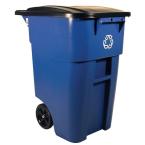
Is Baltimore’s Trash Can Replacement Plan Sound?
Cities try to accomplish many things. They want to keep their people educated and help them climb out of poverty. They want to provide infrastructure that helps people do everyday things. They seek to make people happier and healthier by providing parks and recreation programs. Yet, most of all, they seek to provide basic, reliable service by providers of things like snow removal, trash pickup, sewer service and stormwater removal, and other such tasks generally reserved for municipal government. One of these services is fighting urban pests, most notably rats.
In its bid to reduce rat populations, Baltimore has followed Washington, DC’s lead by seeking to replace all municipal trash cans with newer, supposedly more rat-proof models, which also come equipped with a tracking device. The city deemed a pilot program of 9,000 of the new trash can model a success, as rat control calls in the areas tested fell 75%. The new plan will cost taxpayers about $10 million.
There are two ways one can look at the decision to scale up the pilot program to replace these trash cans. One is as a move toward so-called “smart cities,” where technology is used to improve city services. Another is that the plan is simply a waste of money, and scaling the program up could cause major headaches, as happened in the poorly-executed plan in Washington just last year.
Smart cities are a laudable concept. Things like dynamic pricing for parking and app-based payment make sense for many cities. Using technology to streamline government services is certainly a positive development for municipal government. Many cities, Baltimore included, are seeking to make government better by using technology. Having tracking devices in the trash cans could certainly be part of this, reducing theft and lessening the need for city residents to scrawl their address on cans with spray paint. Lower theft rates would probably offset some of the cost of the initial program. The new standard cans would also be a benefit to city workers, as garbage truck lift arms would be able to reliably handle them, likely cutting wear and tear by reducing lifting of cans that don’t fit the equipment. The standard size could also make it easy for the city to charge heavy waste producers more by volume, introducing more market forces to the garbage removal industry, not unlike congestion fees used to manage traffic. These are the high-tech trash cans of the future, and it seems like $10 million might be a reasonable investment if they really do lower rat abatement costs, which one would hope would mean a smaller staff for the rat control department.
Yet the program is all but a sure win. Perceived ill-repair of trash cans in Washington, DC led to calls for replacement of the city’s trash cans in 2011. In February of last year the replacement began, and so did a series of problems stemming from it. New cans were delivered without notice, while old cans were picked up haphazardly. Residents expressed rage as the old cans being replaced blocked sidewalks and cluttered city streets, seemingly at random. The city promised the old cans would be recycled, going so far as to arrest people for stealing the abandoned bins. Despite their promise, thousands of the replaced cans wound up mixed with general trash, shipped off to Virginia incinerators. The city racked up over $130,000 in unexpected overtime just to collect the cans. The replacement went poorly that DC’s mayor publically expressed his regret for the situation.
While one can hope that replacing the city’s fleet of trash cans will go more smoothly than Washington’s, there is no guarantee it will. As the program expands, city residents should understand the risks when cities announce their grand plans to fix long-term urban problems. At the end of the day, the choice to expand this program falls to Baltimore’s mayor and city council. If the program goes well, they should be praised, but if the program follows the lead of its sister in Washington, they should understand who is to blame for the failure.





